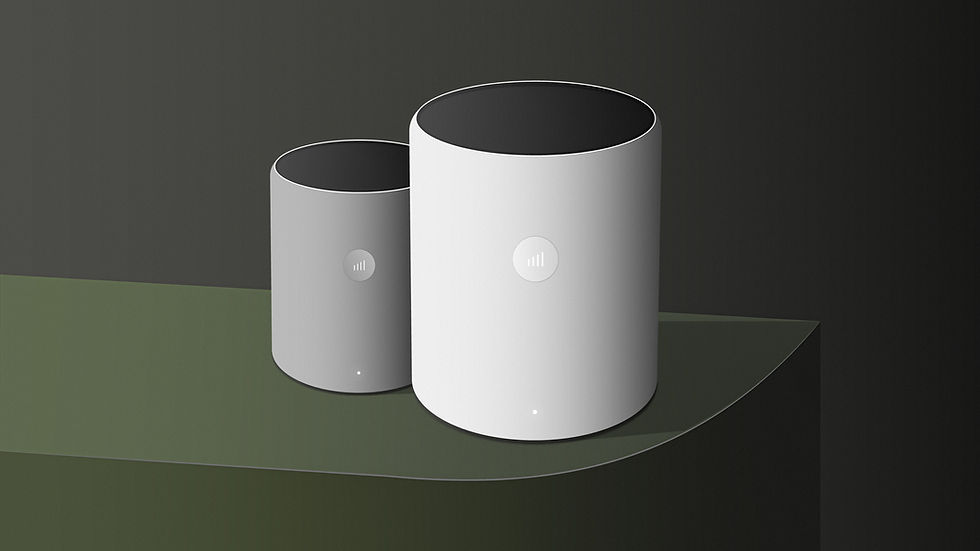The Latest Trends in Audio Technology:
- The Moolah Team
- May 18, 2023
- 11 min read
Updated: May 31, 2023
Audio technology is constantly evolving, with new advancements in headphones, speakers, and soundbars.
In this blog post, we will discuss the latest audio devices and their features, as well as the impact of these technologies on music and entertainment consumption.
I. Introduction: Audio Technology in the Modern Age
Audio technology has undergone a remarkable transformation over the past few decades. From the hissing static of early radios to the crystal-clear sound of digital streaming services, the way we consume and enjoy audio has been revolutionized. With new advancements in headphones, speakers, and soundbars, the options available to us have never been greater.
The evolution of audio technology has been driven by a range of factors, including changes in consumer behavior, technological advancements, and the emergence of new forms of entertainment. One of the most significant developments in recent years has been the rise of digital streaming services, which have transformed the way we access and listen to music.
The proliferation of smartphones, tablets, and other portable devices has also had a major impact on audio technology. Wireless headphones and portable speakers have become increasingly popular, allowing us to listen to our favorite tunes on the go without being tethered to a device.
In this blog post, we'll explore the latest trends in audio technology and how they're impacting the way we consume music and entertainment. From noise-cancelling headphones to virtual surround sound, we'll take a deep dive into the features that make these devices stand out, and how they're changing the way we experience audio.
One of the biggest challenges facing consumers today is choosing the right audio device for their needs. With so many options available, it can be difficult to know where to start. That's why we'll also provide tips and guidance on what to look for when selecting the best audio device for your needs.
As we move into an increasingly digital and connected world, audio technology is sure to continue to evolve and adapt. By staying on top of the latest trends and innovations, we can ensure that we're getting the most out of our audio devices and enjoying the best possible audio experience.
In the next sections, we'll explore the latest trends in audio technology, including wireless headphones, smart speakers, and high-resolution audio. We'll also look at how these trends are impacting music and entertainment consumption, and what the future of audio technology might hold. So, let's dive in and explore the wonderful world of audio technology!

II. Wireless Headphones: Cutting the Cord
Wireless headphones have become increasingly popular in recent years, thanks to their convenience and portability. With no cords to worry about, they're perfect for on-the-go listening and working out.
One of the most significant advancements in wireless headphone technology has been the development of noise-cancellation technology. Noise-cancelling headphones use advanced algorithms to analyse ambient noise and create inverse sound waves that cancel out the noise. This technology can be a game-changer for those who work in noisy environments or who simply want to enjoy their music without any distractions.
Another popular feature of wireless headphones is the ability to customize sound settings. Many headphones now come with companion apps that allow users to adjust the EQ and other audio settings to their preferences. Some models even use AI to analyse the user's listening habits and automatically adjust the sound settings for the best possible experience.
One potential downside of wireless headphones is that they require battery power to operate. While battery life has improved significantly in recent years, it's still important to consider how long the battery will last and how quickly it can be recharged.
In terms of design, wireless headphones come in a variety of styles, from over-ear to in-ear models. Over-ear headphones tend to offer the best sound quality and noise-cancellation capabilities, but they can be bulky and uncomfortable for some users. In-ear models are more compact and portable, but they may not provide the same level of sound quality or noise cancellation.
When choosing a pair of wireless headphones, it's important to consider your personal preferences and needs. Think about how you'll be using them, whether it's for working out, traveling, or simply listening to music at home. Also, consider your budget, as wireless headphones can range from budget-friendly to high-end models with premium features.
Overall, wireless headphones are a great option for those who want the convenience of cord-free listening and the flexibility to customize their audio experience. With advancements in noise-cancellation technology and AI-powered features, wireless headphones are sure to continue to evolve and improve in the years to come.

III. Smart Speakers: Bringing AI into the Home
Smart speakers are a relatively new category of audio devices that have quickly become a staple in many households. These speakers combine the convenience of voice-activated controls with the ability to stream music and other audio content.
One of the main features of smart speakers is their integration with AI-powered virtual assistants, such as Amazon's Alexa, Google Assistant, and Apple's Siri. These virtual assistants can answer questions, provide weather updates, set reminders, and even control smart home devices.
Smart speakers can also be used for music playback, with many models offering access to popular streaming services such as Spotify, Apple Music, and Pandora. Some models also offer multi-room audio capabilities, allowing users to sync multiple speakers and create a seamless audio experience throughout their home.
Another feature of smart speakers is their ability to act as a hub for smart home devices. With compatible devices, users can control their home lighting, thermostats, and even security systems using their voice and the smart speaker.
In terms of design, smart speakers come in a variety of shapes and sizes, from compact models that can be placed on a bookshelf to larger models that can fill a room with sound. Some models also feature built-in displays, allowing users to view weather forecasts, news updates, and other information.
While smart speakers offer a range of useful features and convenience, there are some potential privacy concerns to consider. As these devices are always listening for the wake word that triggers their virtual assistant, there is a risk that sensitive information could be unintentionally recorded and stored. It's important to understand the privacy policies and settings of any smart speaker before bringing it into your home.
Overall, smart speakers are a great option for those looking to bring AI-powered convenience and control into their homes. With their ability to integrate with other smart home devices and provide seamless access to music and other audio content, smart speakers are sure to continue to be a popular choice for consumers.

IV. High-Resolution Audio: The Future of Sound Quality
As technology advances, the quality of audio playback has continued to improve. One of the latest developments in this area is high-resolution audio, which offers a level of sound quality that is far superior to standard CD-quality audio.
High-resolution audio, also known as Hi-Res or HRA, refers to audio that has a higher sampling rate and bit depth than traditional audio formats. Standard CD-quality audio has a sampling rate of 44.1kHz and a bit depth of 16 bits, while high-resolution audio can have sampling rates of up to 192kHz and bit depths of up to 24 bits.
The increased sampling rate and bit depth of high-resolution audio means that it can capture more detail and nuance in the original recording, resulting in a more accurate and lifelike sound. This can make a significant difference, especially for music that has complex instrumentation or is recorded in a large acoustic space.
In addition to the increased sampling rate and bit depth, high-resolution audio also often uses lossless compression, which preserves the full quality of the original recording. This is in contrast to traditional audio formats, which often use lossy compression that sacrifices some of the audio quality in order to reduce file size.
While high-resolution audio offers superior sound quality, it does require specialized hardware and software to playback. This includes high-resolution audio players, amplifiers, and speakers that are capable of reproducing the increased sampling rate and bit depth. In addition, high-resolution audio files can be quite large, which may require additional storage space and processing power.
Despite these limitations, high-resolution audio has gained a following among audiophiles and music enthusiasts who value the highest possible sound quality. Many streaming services and music stores now offer high-resolution audio downloads and streaming options, and there are a growing number of high-resolution audio devices available on the market.
As technology continues to advance, it's likely that high-resolution audio will become more accessible and widely adopted. With its ability to capture more detail and nuance in music and other audio content, high-resolution audio is poised to become the future of sound quality.

V. Voice-Activated Speakers: The Rise of Smart Home Audio
In recent years, voice-activated speakers have become increasingly popular, offering a new way to control home audio systems and access a wide range of music and entertainment content. These devices, which are often referred to as smart speakers, are powered by artificial intelligence and can be controlled through voice commands.
Smart speakers are designed to be easy to use and can be integrated into a variety of home audio systems. They can be used to stream music from a variety of sources, including online music services and local music libraries, and can also be used to control other connected devices such as smart lights and thermostats.
One of the key advantages of voice-activated speakers is their convenience. Users can simply speak a command to play a specific song, artist, or genre, without the need to navigate complex menus or search for content manually. This makes them a popular choice for people who want to enjoy music and other audio content without having to fuss with complicated technology.
In addition to their convenience, voice-activated speakers also offer a high level of compatibility with other smart home devices. They can be used to control a wide range of connected devices, making it easy to create a fully automated and integrated smart home system.
There are a number of popular voice-activated speakers available on the market, including the Amazon Echo, Google Nest, and Apple HomePod. Each of these devices has its own unique features and capabilities, and users can choose the one that best meets their needs.
Overall, voice-activated speakers represent a significant advancement in home audio technology, offering a new way to access and control music and other entertainment content. As these devices continue to evolve and become more sophisticated, they are likely to become even more popular and widely adopted, ushering in a new era of smart home audio.

VI. The Future of Audio Technology: What's Next?
As technology continues to evolve at a rapid pace, it's no surprise that the world of audio technology is constantly changing as well.
So what's next for audio technology?
Here are a few trends and innovations to keep an eye on in the coming years:
3D Audio:
One of the most exciting developments in audio technology is the rise of 3D audio. This technology uses advanced algorithms to create a more immersive audio experience, allowing users to feel like they are truly in the middle of the action. 3D audio can be used in a variety of settings, from gaming and virtual reality to music and movies.
Wearable Audio:
As wearable technology continues to gain popularity, we can expect to see more audio devices that are designed to be worn on the body. This could include everything from smart earbuds that track your workouts to clothing that is embedded with speakers.
Haptic Audio:
Haptic feedback, which uses vibrations to provide physical feedback, is already a common feature in many smartphones and gaming devices. In the future, we may see this technology integrated into audio devices as well, providing users with a more tactile and immersive audio experience.
Personalized Audio:
As AI and machine learning continue to improve, we can expect to see more audio devices that are able to adapt to individual users' preferences. This could include everything from headphones that adjust the audio based on your hearing profile to speakers that tailor the sound to the acoustics of your room.
Sustainable Audio:
With concerns about climate change and sustainability on the rise, we can expect to see more audio devices that are designed with environmental considerations in mind. This could include everything from speakers made from recycled materials to devices that use renewable energy sources.
As these trends and innovations continue to develop, we can expect to see a wide range of new audio technologies that will transform the way we listen to and interact with music and other audio content. From immersive 3D audio to wearable devices and personalized sound, the future of audio technology is full of exciting possibilities.

VII. The Impact of Audio Technology on Music and Entertainment Consumption
Audio technology has had a profound impact on the way we consume music and other forms of entertainment.
Here are a few ways in which audio technology has changed the game:
Streaming:
One of the most significant changes in recent years has been the rise of music streaming services such as Spotify and Apple Music. These services have revolutionized the way we listen to music, providing instant access to millions of songs and allowing users to create personalized playlists and discover new artists.
Mobile Listening:
With the widespread adoption of smartphones and other mobile devices, it's easier than ever to listen to music on the go. This has led to a shift in the way music is consumed, with many users opting for shorter, more bite-sized tracks that are better suited to mobile listening.
Social Media:
Social media platforms like TikTok and Instagram have become major players in the music industry, with users sharing short videos featuring popular songs and helping to launch viral trends. This has had a significant impact on the way music is discovered and promoted.
Gaming:
Gaming has also become a major platform for music consumption, with many games featuring immersive soundtracks and in-game music that can be downloaded and streamed separately. This has opened up new opportunities for musicians and composers to reach a wider audience.
Virtual Reality:
Finally, virtual reality (VR) technology has the potential to transform the way we experience music and other forms of entertainment. VR headsets can provide a fully immersive audio experience, allowing users to feel like they are in the middle of a live concert or other performance.
Overall, audio technology has had a profound impact on the way we consume music and other forms of entertainment. From streaming services and mobile listening to social media and gaming, audio technology has created new opportunities for musicians, composers, and fans alike. As technology continues to evolve, we can expect to see even more exciting developments in the world of audio, further transforming the way we listen to and interact with music and other audio content.

VIII. Conclusion: The Future of Audio Technology
Audio technology has come a long way since the invention of the phonograph in the late 19th century. From vinyl records to cassette tapes, from CDs to streaming, the way we consume music and audio entertainment has constantly evolved. With the latest advancements in headphones, speakers, and soundbars, we can expect even more innovation in the future.
One trend that is likely to continue is the development of wireless audio technology. Bluetooth has become the standard for wireless audio, but newer technologies such as Wi-Fi 6E and UWB (Ultra-Wideband) offer even faster speeds and more stable connections. This means that we may see more wireless audio devices that offer high-resolution audio and low-latency performance, making them ideal for gaming, movies, and music.
Another trend is the integration of voice assistants into audio devices. Smart speakers such as Amazon Echo and Google Home have already become popular, but we may see more audio devices that have built-in voice assistants, such as headphones and soundbars. This would allow users to control their audio experience with voice commands, making it more convenient and accessible.
Finally, we can expect audio technology to become more personalized and adaptive. With the help of AI and machine learning, audio devices can analyse the user's listening habits and preferences, and adjust the sound accordingly. This means that audio devices can optimize the audio experience for each user, regardless of the environment or the content being consumed.
In conclusion, the latest trends in audio technology offer exciting possibilities for music and audio entertainment. Whether it's wireless audio, voice assistants, or personalized audio, the future looks bright for audio enthusiasts. As technology continues to evolve, we can expect even more innovative audio devices and features in the years to come.
In conclusion, the latest trends in audio technology are shaping the way we consume music and entertainment. From wireless headphones to smart speakers, these innovative devices are enhancing our listening experiences and bringing us closer to the music we love. Whether you're a casual listener or a dedicated audiophile, there's something for everyone in the world of audio tech.
We hope you've found this post informative and helpful. If you enjoyed reading it, be sure to subscribe to our newsletter for more updates on the latest trends and innovations in the world of technology. Thanks for reading, and we'll see you in the next one!
Best regards,
Moolah







Comments